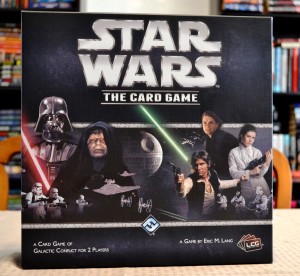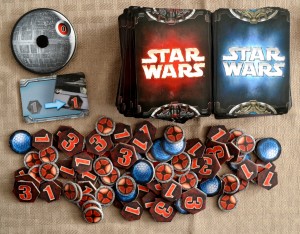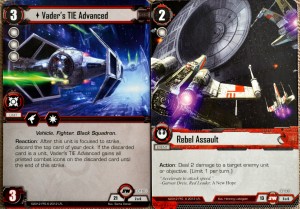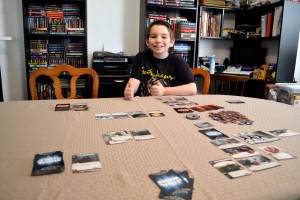I for one am finally glad to see a Star Wars game that doesn’t involve that imbecile, Jar Jar Binks…though there’s always expansion sets. In “Star Wars: The Card Game”, players will be taking on the role of either the Light Side or the Dark Side of the Force. Will you lead Luke Skywalker and company to victory, or will you guide Darth Vader’s hand as he Force chokes all who oppose him?
Components
Cards – The game, as a whole, comes with two hundred and forty cards. Each side has one hundred and seventeen Light/Dark Side cards and three Force cards. The one hundred and seventeen cards that a particular side has are further broken up into nineteen decks of six cards each (called objective sets), along with three affiliation cards. Each deck has one objective card and five accompanying cards of various types.
Death Star Token – This counter tracks the progress of the Dark Side of the Force. It starts out on zero, but if it reaches twelve during the game, then game over for the Light Side.
Tokens – The game includes shield, focus, and damage tokens that track the progression of cards throughout the game. A Balance of Force token also exists to track the Force priority of either the Light or Dark side.
Setup & Gameplay
The first and most important thing to understand about this game is that both players have a unique set of cards, broken up into multiple mini-decks of six cards each (called objective sets). Not all objective sets will be used in a single game. Players will begin choosing one of the three affiliation cards for their side (Rebel Alliance/Smugglers & Spies/Jedi vs. Imperial Navy/Scum & Villainy/Sith). The manual lists the objective sets recommended for each one, though players can customize their forces if they so choose to. It’s important to note however that a player MUST switch out objective sets (all six cards) as a whole…you can’t mix and match individual cards from various objective sets. At a minimum, each player will seed their side with ten objective sets (ten objective and fifty command cards).
Each player will form objective and command decks from the cards they’ve chosen, placing their chosen affiliation card near their objective deck. Four objective cards are drawn by each player. They’ll look at them, choose three, and place them face down near their objective deck. The unpicked card is placed at the bottom of the deck. At the same time, they’ll reveal them. Each player also draws command cards up to their hand size, as indicated on their affiliation card. The Death Star Token is set to zero and the Balance of the Force token is flipped to the Light Side.
Each player will take turns, which are broken up into six phases:
1. Balance – Depending on who has the Force priority (Balance of the Force token), different things will occur. If the Dark Side is showing, the Death Star dial moves two up the tracker instead of just one (Dark Side’s turn only). If the Light Side is showing, the Light Side can deal a damage token to Dark Side objective card of their choice (Light Side’s turn only).
2. Refresh – During this stage, the current player makes sure they have three objective cards showing and corrects that problem if it isn’t the case. They can also remove one focus token from each card.
3. Draw – The current player can discard a card if they’d like, and then draw up to their hand limit.
4. Deployment – Using focus tokens, the player can play them on their objective and affiliation cards to produce resources. Using these resources, the player can play cards from their hand. A card with focus tokens on it is considered exhausted and can’t be utilized in various ways until the focus tokens are removed (via phase two). Deployed cards can perform actions.
5. Conflict – The current player will use this time to attack enemy objectives. Conflicts can be a little complex, but suffice it to say that the defending player may intercept an attack if he has the cards available to do so.
6. Force – At this point, the player can commit some or all of their three Force cards to particular units. Those committed to the Force require extra focus tokens to be used, but count towards the Force total when determining the Balance of the Force.
Players continue taking turns until one side manages to complete their objectives. The Dark Side wins when their Death Star tracker reaches twelve. The Light Side wins when they destroy three Dark Side objectives. Either side loses if they try to draw objective or command cards and can’t.
The above doesn’t cover all of the rules found in the manual, but should give you an idea as to how the game is played. For more information, please refer to the manual linked below:
The Review
I won’t lie…I had to read the instruction manual a few times to get a grasp on what was going on. The hardest part was understanding how all of the cards were organized, though once I saw how the objective and five accompanying cards tied together, it became a bit more clear. Each card has a deck identifier number on it, as well as an X of 6 identifier, which allowed me to clearly see which cards belonged to what objective set when organizing them. These little details went a long way in helping to keep the learning curve manageable.
Having played and reviewed the two Star Trek Deck Building games by Bandai, I was surprised that the card art was hand drawn as opposed to being actual movie stills. I have to say though that the card art is exceptional and full of theme. The hand drawn art almost looks like the real thing…a tribute to the artists who helped to make this game possible.
I thought it was pretty gutsy for the designers of the game to include two different objectives for either side. The Dark Side has the luxury of being able to wait things out, for their Death Star tracker will advance on their turn no matter what. If they happen to gain the Dark Side advantage via the Balance of the Force, all the better. The Light Side is practically forced to go on the offense and destroy those objectives before the Death Star tracker reaches its end. The good news is that both sides play fairly different, giving players a unique experience depending on the side they choose.
Just to name a few examples, Vinnie (12) took control of the Imperial Fleet while I took ownership of the Rebel Alliance for our first game. I had a lot of objective and command cards that did extra damage to enemy objectives. I found myself able to swoop in and do a lot of damage, though I had to remember to pay attention to each card’s special ability to implement them. Vinnie, on the other hand, had more resources at his disposal and brought in the Devastator (a powerful capital ship) and a TIE Bomber. He wiped out one objective with a superlaser card and two more with his ships on following turns. Even though I had Force control throughout the majority of the game, he brought his Death Star tracker from zero to nine in no time flat. If it wasn’t for special abilities and Force priority, I would have lost.
Overall, the experience was a positive one. Our first few games took much longer than the average play time called for, mainly because we were still trying to get used to how the cards interacted with one another. To that end, you’ll definitely want to allot yourself some extra time during your first few games. It becomes much easier to play the more times you cycle through the cards you’re used to seeing. Battles also take a little time to get used to, though I must commend Fantasy Flight for publishing a twenty minute video tutorial, which I linked below. I highly recommend watching it before attempting to decipher the manual.
“Star Wars: The Card Game” takes a little effort to understand, but is well worth the trouble. I really enjoyed seeing the iconic characters duking it out, though I did find it odd that ships and characters were treated on an equal level. This simplifies things a bit by eliminating the complexities of space and ground combat, so I found that I didn’t mind as much. Still, I chuckled a bit when characters like Yoda went up against capital ships like the Devastator…though knowing Yoda, I wouldn’t count him out of the fight completely. Great production values and a lot of room for expansion will keep this game exciting game after game.
Speaking of expansions, there are a number of expansion sets available that provide more decks for players to use. Some even expand the game to three or four players, while others expand on the underrepresented Smugglers and Spies / Scum and Villainy factions. Before spending any cash on them however, I’d highly recommend giving the base game a go first to see if this is a game that you can get into. It’s safe to say however that Vinnie and I most certainly did.
Final Verdict: 8/10
—
You can learn more about and purchase “Star Wars: The Card Game” by visiting the following websites:
http://www.fantasyflightgames.com/edge_minisite.asp?eidm=175
—
http://www.youtube.com/watch?v=c9dWPwoUQ-Y




